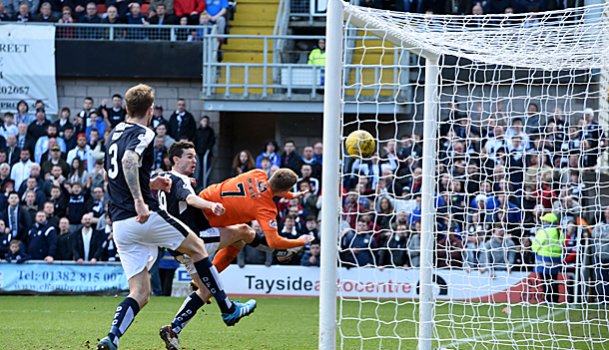Craig Cairns takes his latest tactical look at the SPFL, with the focus on the games at Tannadice, Rugby Park and Tynecastle.
Late drama in the Dundee derby
It is often said that the first goal is all-important. Not so much when it comes to the Dundee derby. In the New Year meeting between the sides, United took the lead before succumbing to two second-half goals. In the first encounter of 2015/16, United blew a two-goal lead, allowing James McPake – thrust up front as an auxiliary striker – to force in the equaliser with seconds remaining.
In Sunday’s Tayside derby the shoe was on the other foot. Dundee led 2-0 at half-time but were undone by a red card to their goalkeeper and a near-45 minutes of sustained pressure from United.
The encounter began with the rare occurrence in Scottish football of a back three versus a back three. Cammy Kerr and Kevin Holt flanked the away side’s central three and played in a less-advanced nature than their United counterparts. Blair Spittal and Paul Dixon, in contrast, tend to play higher up the pitch, leaving space behind them.
Dundee’s front two cleverly exploited this by drifting to the sides of United’ back three. Paul Hartley’s men seemed happy to bypass the midfield and get the ball forward quickly. More often than not, this came in the form of a ball over the top and it allowed their front two of Greg Stewart and Kane Hemmings to take advantage.
That strategy had the Dark Blues 2-0 up at the break but they had been forced to reshuffle their backline twice due to injury. Then, minutes after the restart, Hartley was made to decide upon a 10-man formation after Scott Bain was sent off and Billy McKay pulled one back from the spot.
Hartley opted for a 4-4-1, hoping the two banks of four could withstand the undoubted pressure they would face. Mixu Paatelainen responded by instructing his side to get the ball wide and pile crosses on top of Dundee’s back-up goalkeeper David Mitchell – making his first appearance – and the makeshift back four, which included Paul McGinn at centre-back.
Mixu increased the pressure on Dundee’s defence by throwing on a target man to aim crosses at. Edward Ofere saw a header tremendously saved by Mitchell but was involved in the eventual equaliser. For all their crosses from wide, it was a route-one ball down the middle from Gavin Gunning that created the opening.
Another exciting finish to a Dundee derby at Tannadice but this time it was the home side that left with the momentum. United may have lost an incredible 24 points from winning positions this season but it was their turn to salvage something from a losing situation.
Kilmarnock contain Celtic until the closing minutes
As the cliché goes, the mark of champions is having the ability to take all three points even when you’ve underperformed. With Aberdeen later losing at Motherwell, Tom Rogic’s beautifully-struck effort gave Celtic some much-welcome breathing space.
Celtic made one change from their previous match, replacing Gary Mackay-Steven with Colin Kazim-Richards. He started on the left of a fluid attack, which saw both he and Kris Commons drift in from the wings. Callum McGregor began as the central attacking midfielder but ended the half on the right after switching position with Commons. Even McGregor tended to play narrow and this meant a very congested central area in the Kilmarnock half.
Due to a raft of injuries, Lee Clark’s men had been forced to move Lee Hodson over to left-back and bring in Mark O’Hara on the right. The lack of natural wingers in the Celtic starting XI meant that no one ever looked to get round the outside of Killie’s makeshift full-backs. Kieran Tierney was expected to give Celtic width down the left and did so until he was forced off due to injury and was replaced by the less foraging Charlie Mulgrew.
In the centre of the park, the home side dominated for large spells. Gary Dicker and Julien Faubert kept tabs on Nir Bitton and Scott Brown, while Kallum Higginbotham’s tendency to drift to the left always caused problems during their counter attacks. On a few occasions he linked well with Kris Boyd and almost set up the seasoned striker to open the scoring early on.
Ronny Deila did introduce some width at half-time, in the form of Patrick Roberts. However, even he struggled to sway the game in Celtic’s favour, finding Hodson in fine form. It wasn’t until late in the game that Celtic finally made the breakthrough.
James Forrest had been readied at the side of the pitch for some time before Deila changed his mind and instead decided to bring someone on who could take advantage of the space being opened up in the centre. Rogic was introduced and, as the match crept into injury time, took advantage when Faubert overcommitted. The Aussie subsequently hammered in a superb strike from well outside the box.
St Johnstone end Hearts’ run of clean sheets
“You can’t win anything with kids,” said an ex-Scotland defender once. He was proved wrong then and would likely concede that the Hearts defence of recent weeks would be yet more evidence against that infamous claim. That was until Saturday.
A back four containing two, sometimes three, 19-year-olds had recorded three clean sheets on the bounce before the visit of St Johnstone. For this match, they brought back Blazej Augustyn as captain after another injury to Alim Ozturk.
St Johnstone started the match in a 4-4-1-1 formation. Danny Swanson, who failed to make his mark in the Tynecastle ranks earlier in the season, supported lone striker Chris Kane in attack. Their direct approach was intended to get their team up the park and to pressure the inexperienced Hearts defence.
Even though they didn’t create much from open play, Kane’s persistence helped win a number of corners. For two of these, Murray Davidson lost his man and converted, giving his side a 2-0 lead.
St Johnstone’s second-half strategy was to sit back, protect their lead and hit Hearts on the break. They brought on Steven MacLean to facilitate this and were rewarded with a third goal late in the game.
In a final roll of the dice, Robbie Neilson switched Prince Buaben to central defence and asked the Ghanaian to bring the ball out from the back. It worked to an extent – even if Hearts seldom looked like getting back into the match – but it was his slack pass that allowed Saints to pounce and round off an impressive victory - making them just the second team after Aberdeen to come away with a league victory from Tynecastle this season.





.png)












